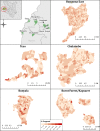Spatial autocorrelation in uptake of antenatal care and relationship to individual, household and village-level factors: results from a community-based survey of pregnant women in six districts in western Kenya
- PMID: 24314170
- PMCID: PMC4029198
- DOI: 10.1186/1476-072X-12-55
Spatial autocorrelation in uptake of antenatal care and relationship to individual, household and village-level factors: results from a community-based survey of pregnant women in six districts in western Kenya
Abstract
Background: The majority of maternal deaths, stillbirths, and neonatal deaths are concentrated in a few countries, many of which have weak health systems, poor access to health services, and low coverage of key health interventions. Early and consistent antenatal care (ANC) attendance could significantly reduce maternal and neonatal morbidity and mortality. Despite this, most Kenyan mothers initiate ANC care late in pregnancy and attend fewer than the recommended visits.
Methods: We used survey data from 6,200 pregnant women across six districts in western Kenya to understand demand-side factors related to use of ANC. Bayesian multi-level models were developed to explore the relative importance of individual, household and village-level factors in relation to ANC use.
Results: There is significant spatial autocorrelation of ANC attendance in three of the six districts and considerable heterogeneity in factors related to ANC use between districts. Working outside the home limited ANC attendance. Maternal age, the number of small children in the household, and ownership of livestock were important in some districts, but not all. Village proportions of pregnancy in women of child-bearing age was significantly correlated to ANC use in three of the six districts. Geographic distance to health facilities and the type of nearest facility was not correlated with ANC use. After incorporating individual, household and village-level covariates, no residual spatial autocorrelation remained in the outcome.
Conclusions: ANC attendance was consistently low across all the districts, but factors related to poor attendance varied. This heterogeneity is expected for an outcome that is highly influenced by socio-cultural values and local context. Interventions to improve use of ANC must be tailored to local context and should include explicit approaches to reach women who work outside the home.
Figures
Similar articles
-
Uptake of skilled attendance along the continuum of care in rural Western Kenya: selected analysis from Global Health initiative survey-2012.BMC Pregnancy Childbirth. 2018 May 16;18(1):175. doi: 10.1186/s12884-018-1803-4. BMC Pregnancy Childbirth. 2018. PMID: 29769047 Free PMC article.
-
Uptake of maternal services and associated factors in the western region of Kenya.Pan Afr Med J. 2020 Oct 29;37:192. doi: 10.11604/pamj.2020.37.192.22406. eCollection 2020. Pan Afr Med J. 2020. PMID: 33505561 Free PMC article.
-
Effectiveness of antenatal care services in reducing neonatal mortality in Kenya: analysis of national survey data.Glob Health Action. 2017;10(1):1328796. doi: 10.1080/16549716.2017.1328796. Glob Health Action. 2017. PMID: 28621201 Free PMC article.
-
Four antenatal care visits by four months of pregnancy and four vital tests for pregnant mothers: impact of a community-facility health systems strengthening intervention in Migori County, Kenya.BMC Pregnancy Childbirth. 2024 Mar 27;24(1):224. doi: 10.1186/s12884-024-06386-2. BMC Pregnancy Childbirth. 2024. PMID: 38539129 Free PMC article.
-
Effects of women's economic empowerment interventions on antenatal care outcomes: a systematic review.BMJ Open. 2023 Mar 13;13(3):e061693. doi: 10.1136/bmjopen-2022-061693. BMJ Open. 2023. PMID: 36914184 Free PMC article.
Cited by
-
Distance matters: barriers to antenatal care and safe childbirth in a migrant population on the Thailand-Myanmar border from 2007 to 2015, a pregnancy cohort study.BMC Pregnancy Childbirth. 2021 Dec 2;21(1):802. doi: 10.1186/s12884-021-04276-5. BMC Pregnancy Childbirth. 2021. PMID: 34856954 Free PMC article.
-
Implementation and Operational Research: Distance From Household to Clinic and Its Association With the Uptake of Prevention of Mother-to-Child HIV Transmission Regimens in Rural Zambia.J Acquir Immune Defic Syndr. 2015 Nov 1;70(3):e94-e101. doi: 10.1097/QAI.0000000000000739. J Acquir Immune Defic Syndr. 2015. PMID: 26470035 Free PMC article.
-
A Scoping Review of Spatial Analysis Approaches Using Health Survey Data in Sub-Saharan Africa.Int J Environ Res Public Health. 2020 Apr 28;17(9):3070. doi: 10.3390/ijerph17093070. Int J Environ Res Public Health. 2020. PMID: 32354095 Free PMC article.
-
Predictors for achieving adequate antenatal care visits during pregnancy: a cross-sectional study in rural Northwest Rwanda.BMC Pregnancy Childbirth. 2023 Jan 26;23(1):69. doi: 10.1186/s12884-023-05384-0. BMC Pregnancy Childbirth. 2023. PMID: 36703102 Free PMC article.
-
Identifying geographical inequalities of maternal care utilization in Ethiopia: a Spatio-temporal analysis from 2005 to 2019.BMC Health Serv Res. 2022 Nov 30;22(1):1455. doi: 10.1186/s12913-022-08850-1. BMC Health Serv Res. 2022. PMID: 36451235 Free PMC article.
References
-
- Lozano R, Wang H, Foreman KJ, Rajaratnam JK, Naghavi M, Marcus JR, Dwyer-Lindgren L, Lofgren KT, Phillips D, Atkinson C. et al.Progress towards millennium development goals 4 and 5 on maternal and child mortality: an updated systematic analysis. Lancet. 2011;12(9797):1139–1165. doi: 10.1016/S0140-6736(11)61337-8. - DOI - PubMed
-
- Cousens S, Blencowe H, Stanton C, Chou D, Ahmed S, Steinhardt L, Creanga AA, Tuncalp O, Balsara ZP, Gupta S. et al.National, regional, and worldwide estimates of stillbirth rates in 2009 with trends since 1995: a systematic analysis. Lancet. 2011;12(9774):1319–1330. doi: 10.1016/S0140-6736(10)62310-0. - DOI - PubMed
MeSH terms
LinkOut - more resources
Full Text Sources
Other Literature Sources
Medical


